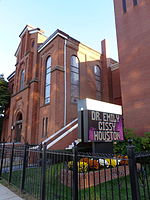Essex County Park Commission Administration Building
Buildings and structures in Newark, New JerseyCounty government buildings in New JerseyCounty government buildings in the United StatesGovernment buildings completed in 1894National Register of Historic Places in Newark, New Jersey ... and 3 more
New Jersey Register of Historic PlacesNew Jersey Registered Historic Place stubsRenaissance Revival architecture in New Jersey

The Essex County Park Commission Administration Building is located in Newark, Essex County, New Jersey, United States. The building was built in 1916 and was added to the National Register of Historic Places on November 11, 1977.
Excerpt from the Wikipedia article Essex County Park Commission Administration Building (License: CC BY-SA 3.0, Authors, Images).Essex County Park Commission Administration Building
Mount Prospect Avenue, Newark
Geographical coordinates (GPS) Address Nearby Places Show on map
Geographical coordinates (GPS)
| Latitude | Longitude |
|---|---|
| N 40.753333333333 ° | E -74.178055555556 ° |
Address
Mount Prospect Avenue 44
07104 Newark
New Jersey, United States
Open on Google Maps









